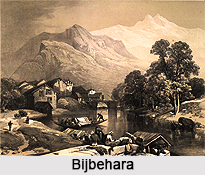 Bijbehara, which is also known as Bijbiara, Vijeshwar or Vejibyor , is a town and a notified area committee in Anantnag district of the Indian state of Jammu and Kashmir.
Bijbehara, which is also known as Bijbiara, Vijeshwar or Vejibyor , is a town and a notified area committee in Anantnag district of the Indian state of Jammu and Kashmir.
Location of Bijbehara
Bijbehara is located at 33.80 degree north to 75.10 degree east. It has an average elevation of 1,591 metres (5,223 feet).
Geography of Bijbehara
The town of Bijbehara is situated in the north of district headquarters on the banks of Jhelum River popularly known here as "Veth". It is one of the notable towns of the district. It is four miles to the north of Anantnag town. Bijbehara is surrounded and intersected by plateaus, including "The Totak Shah", from which the whole town can be seen. There are many other plateaus which are getting urbanised.
Population of Bijbehara
Bijbehara town has population of 22,789 of which 12,057 are males while 10,732 are females as per report released by Census India 2011. Population of the children with age of 0-6 is 3411 which is 14.97 percent of total population of Bijbehara.
Tourism of Bijbehara
The Mughal Prince Dara Shikoh constructed a bridge here which was 100 yards long and 6 yards wide spanning the Jhelum River at Bijbehara near the Mughal garden. The bridge was washed away by heavy floods. The oldest Chinar of the sub-continent is located in the garden popularly called as Padshahi Bagh which is now under the control of Tourist Department. The garden comprises 25 Chinars. The oldest Chinar is 70 feet in circumference at ground level. The Padshahi Garden is 25 canals and 10 marlas. The Dara Shiku Garden is also on the bank of the Jhelum River. The garden is of 224 canals area. Padshahi Garden and the Dara Shikoh Garden are separated by the river Jehlum which is spanned over by a bridge known as "Padshahi Bagh Bridge", thus connecting the two gardens. Guru Nanak had also come to this town and presently a Gurudwara under name Shri Guru Nanak Dev Ji Pehli Padshahi Gurudwara Bijbehara is at this place. Bijbehara finds mention in Rajtarangini by the ancient poet, Kalhan. Bijbehara is also famous for temples of Chakradhar and Vijayeshwar. Vijayeshwar temple was built by King Shachinar. This temple was reconstructed again during the reign of Anantdev. This fortified temple was a famous site in then Kashmir.



















